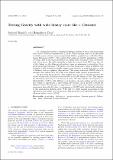Files in this item
Testing Gravity with Wide Binary stars like α Centauri
Item metadata
| dc.contributor.author | Banik, Indranil | |
| dc.contributor.author | Zhao, Hongsheng | |
| dc.date.accessioned | 2018-07-31T15:30:08Z | |
| dc.date.available | 2018-07-31T15:30:08Z | |
| dc.date.issued | 2018-10-21 | |
| dc.identifier | 255125596 | |
| dc.identifier | cce5e025-3082-4a9b-9376-b9c75a646e21 | |
| dc.identifier | 85055161456 | |
| dc.identifier | 000449614800095 | |
| dc.identifier.citation | Banik , I & Zhao , H 2018 , ' Testing Gravity with Wide Binary stars like α Centauri ' , Monthly Notices of the Royal Astronomical Society , vol. 480 , no. 2 , pp. 2660–2688 . https://doi.org/10.1093/mnras/sty2007 | en |
| dc.identifier.issn | 0035-8711 | |
| dc.identifier.other | ORCID: /0000-0002-4123-7325/work/47136595 | |
| dc.identifier.uri | https://hdl.handle.net/10023/15735 | |
| dc.description | Funding: IB was partially supported by Science and Technology Facilities Council studentship 1506672. | en |
| dc.description.abstract | We consider the feasibility of testing Newtonian gravity at low accelerations using wide binary (WB) stars separated by >∼ 3 kAU. These systems probe the accelerations at which galaxy rotation curves unexpectedly flatline, possibly due to Modified Newtonian Dynamics (MOND). We conduct Newtonian and MOND simulations of WBs covering a grid of model parameters in the system mass, semi-major axis, eccentricity and orbital plane. We self-consistently include the external field (EF) from the rest of the Galaxy on the Solar neighbourhood using an axisymmetric algorithm. For a given projected separation, WB relative velocities reach larger values in MOND. The excess is ≈20% adopting its simple interpolating function, as works best with a range of Galactic and extragalactic observations. This causes noticeable MOND effects in accurate observations of ≈500 WBs, even without radial velocity measurements. We show that the proposed Theia mission may be able to directly measure the orbital acceleration of Proxima Cen towards the 13 kAU-distant α Cen. This requires an astrometric accuracy of ≈1 μas over 5 years. We also consider the long-term orbital stability of WBs with different orbital planes. As each system rotates around the Galaxy, it experiences a time-varying EF because this is directed towards the Galactic Centre. We demonstrate approximate conservation of the angular momentum component along this direction, a consequence of the WB orbit adiabatically adjusting to the much slower Galactic orbit. WBs with very little angular momentum in this direction are less stable over Gyr periods. This novel direction-dependent effect might allow for further tests of MOND. | |
| dc.format.extent | 1675194 | |
| dc.language.iso | eng | |
| dc.relation.ispartof | Monthly Notices of the Royal Astronomical Society | en |
| dc.subject | Gravitation | en |
| dc.subject | Dark matter | en |
| dc.subject | Proper motions | en |
| dc.subject | Binaries: general | en |
| dc.subject | Galaxy: disc | en |
| dc.subject | Stars: individual: Proxima Centauri | en |
| dc.subject | QB Astronomy | en |
| dc.subject | QC Physics | en |
| dc.subject | Astronomy and Astrophysics | en |
| dc.subject | DAS | en |
| dc.subject.lcc | QB | en |
| dc.subject.lcc | QC | en |
| dc.title | Testing Gravity with Wide Binary stars like α Centauri | en |
| dc.type | Journal article | en |
| dc.contributor.institution | University of St Andrews. School of Physics and Astronomy | en |
| dc.identifier.doi | https://doi.org/10.1093/mnras/sty2007 | |
| dc.description.status | Peer reviewed | en |
| dc.identifier.url | https://academic.oup.com/mnras/article/480/2/2660/5060764?guestAccessKey=180aba7d-6e2a-4ec5-89c6-21a9556bfda3 | en |
| dc.identifier.url | https://arxiv.org/abs/1805.12273 | en |
This item appears in the following Collection(s)
Items in the St Andrews Research Repository are protected by copyright, with all rights reserved, unless otherwise indicated.

